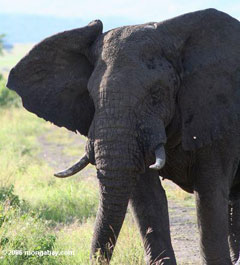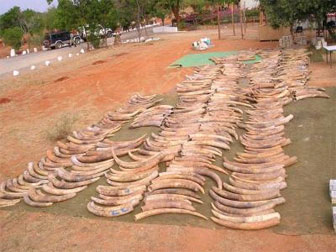China drives elephant poaching for ivory trade
China drives elephant poaching for ivory trade
Thousands of elephants killed for resurgent ivory market in China
Rhett A. Butler, mongabay.com
February 26, 2007
Thousands of African elephants are being killed for their ivory tusks, according to a new study led by a biologist from the University of Washington.
In a paper published in the online edition of the Proceedings of the National Academy of Sciences, Dr. Samuel Wasser, director of the University of Washington Center for Conservation Biology, shows that elephants are being slaughtered at the highest rate since the international ban on the ivory trade took effect in 1989.
Wasser reports that authorities seized more than 23,400 kilograms (nearly 24 tons) of illegal ivory for the year ending in August 2006. Wasser reckons this number represents only about 10 percent of the total trade, so the actual amount of poached ivory probably is closer to 234,000 kilograms. To produce this volume of ivory means that 23,000 elephants — about 5 percent of Africa’s remaining population — were killed.
Wasser says that Chinese demand for ivory is driving the black market where the material sells for $750 per kilogram, up from $100 in 1989 and $200 in 2004. The high prices have attracted organized crime which run sophisticated trafficking networks.

African elephant in Uganda. Photo by Rhett A, Butler |
“If it really is organized crime that’s driving this, then the only hope we have of stopping it is to stop the ivory at the source, to not let it into the international market. Because once it’s in the international market, the trade is very hard to stop,” said Wasser, who, along with colleagues, is working to help authorities track seized ivory to its source using DNA-testing. Their research suggests that a 6.5-ton shipment, which was busted in Singapore in 2002, probably came from Zambia.
“Shortly before the seizure, Zambia had petitioned for permission to sell its ivory stockpiles internationally, stockpiles that were supposed to have existed before the international ban took effect in 1989,” explained a statement from the University of Washington. “But the application said only 135 elephants were known to have been killed illegally in Zambia in the previous 10 years, far fewer than would have had to be slaughtered to produce the ivory in just the single seizure in 2002.”
Wasser says that Zambia, being a poor nation, needs Western help to address the trade. While Western Nations contributed generously in the four years after the ivory ban was implemented in 1989, their success in stopping the trade spawned complacency in subsequent years and eventually money for enforcement dried up and ivory poaching lacerated.

Tusks from the second-largest contraband ivory recovery in history are laid out on the ground in Singapore after they were seized in 2002. Photo by Benezeth Mutayoba. |
Wasser and colleagues say that while reinstatement of enforcement efforts is important, the key to tackling the illicit trade is education efforts in both Africa, where ivory is harvested, and Asia, where ivory is consumed.
“If people really realized what is happening they would be ashamed to be part of the crisis,” he said. “We don’t want to spend our time catching criminals, we want to stop the crime from happening. That’s the most effective enforcement you can do.”
Between 1970 and 1989, the African elephant population fell from 1.3 million to about 600,000 in 1989. The current population is estimated to be between 400,000 and 660,000. The African elephant is Earth’s largest land animal.